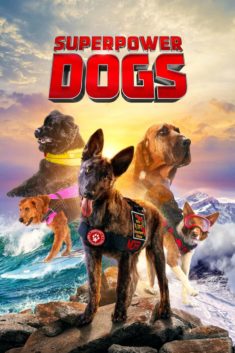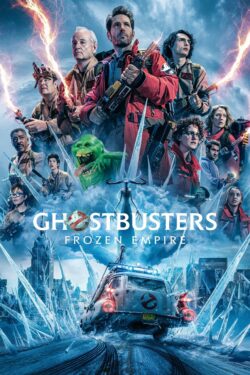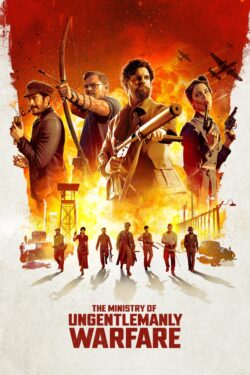Superpower Dogs (2019)
Animal Action

The dogs in this film are real. They were filmed with their actual owners.
In the scene where a man is in a helicopter and a dog is in his lap, the owner and the dog were strapped into the helicopter. The dog was also wearing goggles to protect his eyes. This was an experienced search and rescue pilot. He and his dog had worked together on many missions in the past. The dog was conditioned to flying in a helicopter.
When we see the handler and his dog going up a mountain on a snowmobile, this dog regularly went on rides on this snowmobile as part of his work regimen. The dog was kept secure by his handler flanking both sides of the dog’s shoulders, holding him in place. In the scene where we see puppies, American Humane was on set to make sure the puppies were well taken care of, and placed in a warm area after filming them.
In the scenes regarding the water rescue dogs in Italy, only the trainers handled and fed their dogs. Also, the dogs were used to being on-board boats and jumping into the ocean since water rescue is their day to day job. The dogs were also taken to land with the zodiac boat after the dogs had been on board for two hours so that they could have a toilet break and a walk.
Once the position of the dogs was established for filming they were moved to the shade as there was no wind and the wind was needed for filming to get the sails up. All of the dogs lived stayed at local hotels with their handlers for the duration of the shoot. When we see the dogs jump in the water, leading the rescue workers, the dogs were conditioned to this kind of action. The dogs also wore harnesses to help pull victims from the water. The dogs all wore their own floatation vest and harness, their day to day safety outfit for water rescues.
In the scenes in Northern Kenya, American Humane was there to oversee all the animal action. The dogs were well trained and the anti-poaching dog unit from Lewa Conservation Area were part of productions before so they understand what was expected. The helicopters and aerial views caught all the elephants, rhinos and buffalo in their natural habitat. When we see the dogs sitting with their handlers on top of a hill, production drove them to the top of the hill prior to shooting. The dogs did not have to scale that hill. Whenever we see the soldiers walking the dogs through the grassy areas, with rhinos in the background, the dogs kept their distance from the other animals. The dogs were given water continuously.
In the scene where we see the firefighters walking with the search and rescue dogs down a tarmac, the dogs were either in their crates or on lead at all times. They were continually given food and water. It was a nice cool day with a breeze so the asphalt was not hot to the touch. When we see the dogs running through the rubble searching for survivors, this was a closed area. The dogs were trained to perform the animal action needed. The production did not interfere with the trainers and dogs throughout the process. The test was done once and recorded, and the dog found all of the people hidden inside the rubble. Then, the dogs were recorded with their owners in an interview sitting on a leash.
In the scene where we see the dog surfing on the ocean, the dog working that day was a real service dog that’s used to working with autistic kids and grown adults with PTSD. He had a safety crew at the surf board and a pick up a crew at the shoreline. The dog was wearing a wetsuit to keep her warm and a life vest as well. The dog was always carried out to the ocean and given multiple breaks throughout the day. The trainers were with the dog at all times. They were always in the water up to their waist or chest and flanking the dog and the kid on the board. The trainer brought the dog into the water in his arms and placed the dog on the surfboard. The kids were always placed on the board after the dog was set. The dog was comfortable being on the surfboard and liked it. The trainers signaled when a good wave was coming, let the board go and the dog and kid would surf a gentle wave to the shoreline where there would be volunteers to pick up the kid. The trainer would hold onto the back of the surfboard and lower his head in the water and ride along with the dog and kid. He did this to prevent the board from tipping over due to the heavy camera mounted on it.
In the scene where we see nearly one hundred dogs with their owners in the park, interacting with each other, there was one person per dog on leash, with dogs over a year old and sterilized with good temperament. The park was open to the public and the staff monitored the dog walkers to continue through the paths. The dogs and their owners were encouraged to wait in the shade between takes.
When we see the dogs with their soldiers in the airplane, the dogs and their handlers were loaded into the cargo plane. The handlers were strapped in and sitting in jump seats with the dogs sitting beside them on the floor. The dogs all had on their collars, vest and leads. There was Air Force personnel on board to open and close the hydronic
cargo door on the plane. On action, the soldier hit the button and the cargo door opened to reveal the K9 teams
Due to late notification and/or limited resources, American Humane Association did not monitor some of the dog action.




